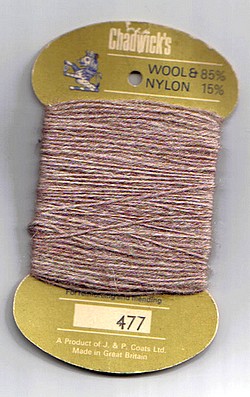 By Sully, Underground Correspondent in charge of arcana.
By Sully, Underground Correspondent in charge of arcana.EVERYONE has a few Pheasant Tail Nymphs in their box. Frank Sawer's deceptively simple pattern has developed a worldwide following.
Precious few anglers, though, have even heard of the
Sawer Killer Bug. As with the P.T., Sawer chronicled the development, tying and fishing of the Killer Bug in "
Nymphs and the Trout".

First published in 1958, this bountiful book explains how Sawer developed the simple cigar-shaped bug to catch grayling in the upper Avon.
In that role the Killer Bug has achieved almost cult-like status in the British Isles and Europe. In grayling-poor America, however, the fly hasn't received the recognition it deserves.
The bug was tied to imitate the creature anglers call freshwater shrimp (ammarus pleus in England).
Simple Pattern. Killer Results?In the profoundly minimalist manner that led Sawer to omit legs from his P.T. Nymph, he left off the antennae, shiny carapace, the multiple legs and leglike appendages (gnathopods and pleopods) that spell "shrimp" to human beings.
It's like drawing a rabbit without adding the ears. What's left is a copper wire foundation with wool wrapped over it. That's it.
Sawer on the obvious, "Once again this is of very simple construction, so simple indeed that anyone looking at it could be forgiven for thinking it could deceive a fish."
There almost has to be a hitch in something this elegant. There is.
The Killer YarnSawer specified that the body material for the Killer Bug had to be a particular color of mending yarn, a mixture of wool and nylon; Chadwick's 477. He had extensively experimented and nothing else fished as well.
Nowhere in "Nymphs and the Trout" is there a description of the color of this magical yarn. The tease is that the color of the bug changes completely when wet. According to Sawer, ""¦ it is this that causes its attraction for so many kinds of fish."
Thanks for raising our hopes, Frank. All a Chadwick-less angler has to do is ascertain the color that's irresistible to shrimp-eating fish when wrapped around red copper wire and wetted.
Charles Ritz fished with Sawer and became a devote of the Killer Bug. In "
A Fly Fisher's Life" Ritz writes that the bug is tied with "grey wool," but some subtleties might have been lost in translation from the French.
Other descriptions of the blend have described it as "fawn with a pinkish tinge" and "red, brown and grey."
Where was the Borger Color System when we needed it?
Help Isn't on the WayIn 1958 Chadwick's 477 was, to quote Sawer, "not very easy to obtain". Naturally Chadwick's immediately ceased production of the stuff, knowing that flyfishermen as a breed are particularly susceptible to the allure of arcane materials.
From the first time I first read about the Killer Bug I knew that I had to get some Chadwick's 477.
Sometime in the late 1970's an obscure advertisement appeared in an early issue of Flyfisherman Magazine. A company identified only by initials located in
Ogden, Utah was offering the original Sawer Killer Bug yarn for sale.
The whole setup sounded perfect. An obscure group situated in the middle of the desert would be the logical source for something this arcane and powerful.
I have no idea if anyone else acted on the ad. (Maybe selling discontinued darning wool isn't a foolproof business plan.) Maybe the illuminati simply moved to a different dimension.
My letter requesting more yarn several years later was returned by the Post Office. After a couple of decades I'm now left with just a few turns of the precious two-strand darning wool.
Substitues? Not LikelyThe color? Well, it's easy to see how Charles Ritz could stop short with the word "grey." It's a thatched-roof cottage, gather around a bowl of steaming gruel kind of color. 477 apparently was developed for darning knickers torn on Highland gorse. It's easy to see why Chadwick's discontinued the stuff: no one has worn a garment this color since V-2's stopped raining on London.
My artist wife calls the color "taupe": a word like "holistic" that contains no substance.
If you are one of the dozens of anglers with access to "Fly-tyer's Color Guide" by Al Caucci and Bob Nastasi look up 4y2r3b23w. How does gray, with subtle overtones of tan describes the color? That's the base color to the dry yarn.
When wet it does display a pinkish overtone. To the point; when the yarn is presented to fish over a red copper base it fully merits the name "Killer."
Who Eats This Stuff?Scudding fish, sow bug eaters, fish grubbing pre-emergent caddis, heck, fasting fish are all susceptible to the fly. Quite a few years ago a short blurb appeared in Ed Story's Feather-Craft newsletter. It promised Chadwick's original 477. Naturally I bit.
When the stuff arrived it was a disappointment. It was much browner that the original yarn. Too "fawny". But we tied Killer Bugs with it and they worked, too.
Sawer tied the fly in sizes 3 through 10 using the reverse- numbered Kendal nomenclature (comparable to our Redditch sizes 14 through eight) and fished the fly for everything from grayling to, and this is both astonishing and compelling, Atlantic salmon. Locally we stick with smaller sizes, 14 down to 18. The fly is especially effective in the fall.
Read More Big Fall FishingA few years ago Paul Redfern, the crafty owner of FishOn Fly and Tackle in Butte managed to score a few inches of certified Chadwick's 477 from an English tier. Sure enough the stuff from Utah was the real deal.
You got some you want to send to Sully?